| Lot |
Photo |
Description |
Realized |
Lot 905 |
 |
T-Rex Pre-Maxilary 2.5 Inch Tooth. Virtually all T-Rex teeth found are shed teeth that broke off when the T-Rex was feeding on some other dinosaur. Usually these teeth are just fragments or are broken into many pieces, but this large 2.5 inch Pre-Maxilary light brown tooth is the exception. Only � inch of the tip was found separated from the rest of the tooth and put back into place. Otherwise there is no restoration to this magnificent tooth. There is some wear on the enamel at the tip that occurred when the T-Rex was still alive and there are some light cracks in the enamel that are always present, but the enamel is of exceptional quality and the serrations are fairly sharp. This is a really large Pre-Maxilary tooth as the Pre-Maxilary teeth are smaller than the teeth further back in the jaw because Pre-Maxilary teeth are found in the front of the jaw and were used to strip meat from the bone. They are very distinctive in having two rows of serrations close together on the inner curve of the tooth versus having one row of serrations on the opposite sides of the regular teeth. This 65 million year old treasure was found on a private ranch in the Hell Creek Formation of Montana and is displayed in a 6X6 inch Riker Mount.
Estimated Value $4,000 - 5,500.
View details and enlarged photo
| Unsold |
Lot 906 |
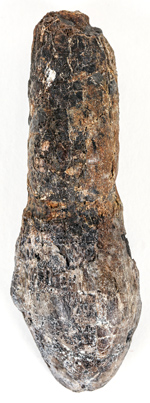 |
Huge Camarasaurus Tooth With Root. Camarasaurus was a huge saurapod plant eating dinosaur that lived 150 million years ago in the Morrison Formation of Colorado. Camarasaurus, its name meaning "chambered lizard" referring to the hollow chamber in its vertebra lived alongside other more famous saurapod behemoths such as Diplodicus and Apatosaurus (Brontosaurus). This huge Camarasaurus tooth is 3.5 inches long consisting of a 1.7 inch enameled tooth and a 1.8 inch mostly complete root. Most teeth of dinosaurs are found without their root because they were lost while the dinosaur was still alive. However, rooted teeth would only be lost when the dinosaur died. Camarosaurus has a larger and sturdier skull than the Diplodicids and its teeth were much larger and of a totally different shape. This Camarosaurus tooth is shaped like a chisel unlike the slender pencil shaped teeth of the Diplodicids. The shape of its teeth indicates that Camarasaurus ate different types of vegetation from the other saurapods, most likely coarser plants that grew closer to the ground. Saurapod teeth are much rarer than theropod teeth because they did not lose their teeth biting into other animals flesh and bone. This large and rare tooth is in a 8X6 inch Riker mount.
Estimated Value $3,500 - 4,000.
View details and enlarged photo
| Unsold |
Lot 907 |
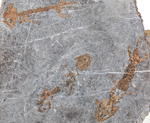 |
Three Primitive Amphibians. Discosauriscus pulcmerismus was an early 260 million year old amphibian unrelated to modern amphibians that somewhat resembled a salamander with a huge head and scaly and rough skin. Discosauriscus was an active predator in lakes and shallow pools. The two specimens on this 13X11 inch plate feature one 8 inch long specimen from the ventral position showing rows of small sharp teeth and one 7 inch specimen with a dorsal view showing the solid bony skull. Also, on the same slab is a ventral view 6 inch long Microperpetron amphibian also showing some teeth. It is rare to find even one amphibian specimen but finding three on one plate is exceptionally rare. These museum quality specimens were found in a quarry near Letovice in the Czech Republic.
Estimated Value $2,750 - 3,750.
View details and enlarged photo
| Unsold |
Lot 908 |
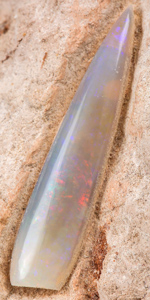 |
Opalized Belemnite. The best quality of fire opal comes from the famous Coober Pedy region of Australia. Coober Pedy is a very small town in northern South Australia. As rare as fire opals are, they are much rarer to find in a fossil. This 3.5X2.5 inch natural beige colored stone matrix contains a 36mm (about 1.5 inch) 120 million year old opalized belemnite that has been polished to reveal the fine fire opal colors of orange, purple and green. Belemnites are an extinct group of cephalopods that are related to squid and the chambered nautilus. The only part of the extinct belemnite that fossilizes is the torpedo shaped shell that is contained inside its body and makes it rigid for swimming. This is a rare opportunity to purchase a gemstone (Opal) contained in a 120 million year old fossil.
Estimated Value $2,700 - 3,500.
View details and enlarged photo
| Unsold |
Lot 909 |
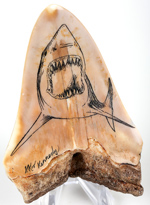 |
Carcharodon Tooth With Scrimshaw. Carcharodon megalodon was the largest shark that ever lived growing to more than 50 feet in length and ate whales whose bones are found right alongside with the huge teeth of megalodon. This 4.5 inch on the diagonal and 2.8 inches wide 15-20 million year old Carcharodon tooth was found in a deep water location (over 1000 feet) that was a three day boat ride north of a small island called New Caledonia. New Caledonia is in the South Pacific Ocean about 800 miles east of Australia. These teeth are dredged from this depth and most of the teeth are broken. This complete tooth has various tones of pastel beige enamel which is perfect for carving scrimshaw. The root is a pleasing light brown in color. Everything is original with no restoration on the tooth. Scrimshaw is a 16th century art form that originated with sailors who etched drawings onto whale teeth and filled in the scratches with ink. This intricate representation of a megalodon shark with gaping jaws and huge sharp teeth was carved and then inked into the real enamel on the flat side (outer side) of the megalodon tooth. This miniature piece of art is signed and dated by the artist, Kelly Kennedy 2005 at the bottom of the seafloor. Kelly Kennedy was renowned as a scrimshaw artist and died in 2008. Presented on a small plastic stand for display.
Estimated Value $2,000 - 2,750.
View details and enlarged photo
| Unsold |
Lot 910 |
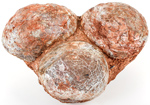 |
Three Egg Partial Dinosaur Nest. These three large complete inflated unhatched Duckbill dinosaur eggs come from a collection put together over 15 years ago and are 70-80 million years old. These large 6-6.5 inches in diameter are of museum quality with two of the eggs having 75- 85 percent of their original shell intact. The Third egg has about 50% original shell. These eggs are completely original with grayish brown fossilized eggshell nicely contrasting the original 12X9 inch red brown matrix typical of the dinosaur eggs found in Northeast Asia. We do not know what Duckbill species these eggs belong to as no embryonic bones have every been found in the Duckbill dinosaur eggs, but being the largest Duckbill egg at a gigantic 6.5 inches in length (most eggs being 5-5.5 inches long), they probably belong to one of the larger duckbill dinosaurs also known as Hadrosaurs. These museum quality dino eggs make an excellent display having much more original egg shell than normally found and resting on the original reddish brown limestone matrix. Dinosaur eggs are becoming hard to locate and rising sharply in value especially for original unrestored eggs.
Estimated Value $1,800 - 2,500.
View details and enlarged photo
| Realized
$1,080 |
Lot 911 |
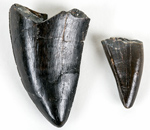 |
Two Different Types of T-Rex Teeth. Virtually all T-Rex teeth found are shed teeth that broke off when the T-Rex was feeding on some other dinosaur. Usually these teeth are just fragments or are broken into many pieces, but this lot consists of two virtually complete shed T-Rex teeth without the root that were found within a few feet of each other in the 66-67 million year old Lance Creek formation of Wyoming. There is no restoration to either tooth. The larger 1.75 inch thick typical jaw tooth has excellent enamel and sharp nearly complete serrations with a perfect intact tip and interesting ripples in the pristine enamel. The other tooth is a 1 inch long Pre-maxilary tooth from the very front of the mouth and has excellent enamel with some wear on the enamel at the tip that occurred when the T-Rex was still alive and some serrations but they are not sharp. The Pre-maxilary teeth are very distinctive in having two rows of serrations close together on the inner curve of the tooth versus having one row of serrations on the opposite sides of the regular teeth. This set of the two different types of T-Rex teeth may be from the same juvenile T-Rex with superb dark brown color and are displayed in a 8X6 inch Riker Mount.
Estimated Value $1,700 - 2,500.
View details and enlarged photo
| Realized
$1,046 |
Lot 912 |
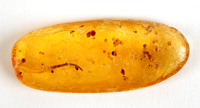 |
Lizard Tail In Madagascar Copal. Although insects are common in amber or copal, larger creatures such as lizards are rarely encountered because they are much bigger and can just walk away out of the gooey tree resin. Copal is just young amber that has not had the time to harden. This rare and spectacular .75 inch fossilized Lizard tail with four fossilized blood droplets is contained within 1.75 inch clear fully polished cabochon of two million year old Madagascar copal. This fossil tells a story of a small lizard being trapped in tree resin and then shedding his tail to free himself and in this act leaving four blood droplets which still remain fossilized in this extraordinary specimen. This lizard tail is beautifully preserved with excellent scales and brown color markings with bright red blood droplets. Both lizard and blood are extremely rare in copal or amber and complete small lizards have sold for more than $50,000 in amber. Presented in an 8 x 6 inch Riker mount. Add $20 for domestic shipping.
Estimated Value $1,500 - 2,000.
View details and enlarged photo
| Unsold |
Lot 913 |
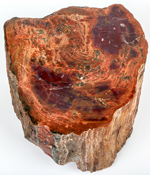 |
Petrified Rainbow Colored Wood. This large 10X9.75X5.5 inch agatized and polished partial lob of petrified wood from the Araucarioxylon tree has a wonderful mix of rainbow colors that resulted from many different minerals permeating the wood at different times from the volcanic soil over millions of years. The highly polished top of the 5.5 inch high log has an artistic palette of colors with shades of burnt orange, hues of browns, burgundy and cream. The unusual shades of burnt orange and burgundy colors were produced by replacement by various iron oxides. Most of the original bark still remains on all of the sides of this heavy 39 pound log. Araucarioxylon arizonicum is an extinct 225 million conifer tree that is the state fossil of Arizona and known to all visitors to the Painted Forest National Park. A sizeable and beautiful specimen of petrified wood.
Estimated Value $1,000 - 1,400.
View details and enlarged photo
| Unsold |
Lot 914 |
 |
Carcharodon Megalodon Shark's Tooth. Even though Carcharodon megalodon was the largest shark that ever lived growing to more than 50 feet in length most of the teeth found are only 3-4 inches in length. Teeth over 5 inches in length are in great demand. This huge 5.8 inch 15 million year old Carcharodon tooth was found in the muddy river waters of South Carolina. Estimating the length of a shark at about 10 feet in length to every one inch of tooth, this behemoth would be close to 60 feet long. This huge tooth has a complete black root and nicely contrasting greenish gray enamel. There are excellent sharp serrations on the edge and the enamel is outstanding with the usual small amount of chipping between the top of the enamel and the black root. The consigner purchased this museum quality tooth as being completely natural with no restoration. However, about � inch of the very tip appears to have been professionally repaired with an outstanding color match with the balance of the tooth. This tooth has a fabulous look with the extremely sharp serrations that are so often missing or dull. Comes on a custom Megalodon wooden stand.
Estimated Value $1,000 - 1,300.
View details and enlarged photo
| Realized
$810 |
Lot 915 |
 |
Large Mancherochelys Turtle. Turtles are unique in the animal world having their entire torso embedded in a bony shell casing. There still is no consensus about their origins. Turtle fossils are usually just the carapace without the head and limbs. This 125 million year old 9.5 inch long Mancherochelys sp. fossil from Liaoning, China is the rare exception having an excellent 3-D1.5 inch skull, carapace and parts of all four limbs and tail. The limbs and tail have become somewhat disarticulated in the fossilization process. This turtle has a complete shell and its light brown color is nicely contrasted against the lighter beige 10X7 inch stone matrix. Mancherochelys was a Crytodira turtle that could not withdraw its head and limbs inside like modern turtles. A rare spectacular and well detailed fossil turtle.
Estimated Value $1,000 - 1,500.
View details and enlarged photo
| Realized
$2,153 |
Lot 916 |
 |
Rare Fish Aspiration From Green River. Green River, Wyoming is very famous for its 52 million year old fish fossils. Some of the rarest of all the fish fossils found in these limestone quarries are those that capture the moment in time when a fish choked to death trying to swallow another fish whole. This is known as a fish aspiration fossil. Most fossils preserve an animal after they die but the cause of their death is unknown. A fish aspiration captures the exact moment of their death as a fossil. This 5.75 inch long Mioplosus aspirated while swallowing a 1.5 inch long Knightia. A full 1.25 inch of the Knightia is fossilized sticking out of the mouth of the Mioplosus. Mioplosus, an extinct relative of the modern bass, was a voracious predator (several small sharp teeth are preserved in this fossil) that fed on any smaller fish that it could swallow. This rare dramatic fossil is preserved as a 52 million year old snapshot in time on its natural 9X7 inch limestone matrix.
Estimated Value $1,000 - 1,500.
View details and enlarged photo
| Realized
$720 |
Lot 917 |
 |
Museum Quality Sea Scorpion. Eurypterids, also known as sea scorpions, were fierce predators in the warm seas 425 million years ago. Some grew to over 6 feet long and easily hunted the slow moving armored fish of that era. Eurypterids were related to scorpions and were probably the first animal to leave the sea and crawl out on dry land. This complete highly detailed 4.25 inch sea scorpion, Eurypterus remipes comes from the famous 425 million year old Fiddler's Green Quarry of Herkimer County, New York. This magnificent specimen is exceptionally rare in that it is complete with all six of the walking legs as well as the two paddles being preserved with excellent detail along with an excellent head, body and telson (looks like the stinger in a scorpion but was not poisonous). The walking legs have amazing detail with the first two pairs of legs having feather-like ends that were used to sense prey. This Eurypterid is preserved in its underside (ventral position) that also enables some detail of its mouth as well. This is the very best quality for a sea scorpion with fewer than one in a hundred being even close to the quality of this specimen. This museum quality Eurypterids is nicely centered on a 6.5X4.25 hard gray matrix.
Estimated Value $1,000 - 1,500.
View details and enlarged photo
| Unsold |
Lot 918 |
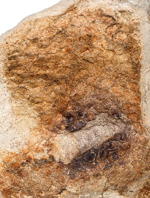 |
Dinosaur Skin With Soft Tissue. Dinosaur skin is the rarest and most coveted of dinosaur fossils because of its extreme rarity being preserved only under extraordinary conditions. The dinosaur had to have been completely covered by fine mud sediments probably in a large river delta within a day or so after dying to avoid bacterial breakdown of the skin and soft tissue which would occur immediately. The skin texture was impressed in detail in the soft clay forming a natural mold which was later filled by more muddy sand creating a natural cast and remained intact for over 65 million years even after the skin and other soft tissue was destroyed by bacteria. This large section of dinosaur skin is from the back of the hip or tail section of an Edmontosaurus duckbilled dinosaur and is between 65-70 million years old and was found along with some fragmented Edmontosaurus bones in the Hell Creek Formation of Montana. Also, soft tissue has also been fossilized along with the skin. This large section of matrix is 10.5X7 inches and has deep very distinct skin impressions on both sides of the limestone rock. The best detailed skin is 4X4 inches showing excellent detail and color with a large 8X2 inch skin section curving beneath it. Also present on the bottom of this 8X2 inch skin section is a 2.5X2 inch dark brown imprint of the muscle or gland that was present just beneath the skin. On the back of the slab is another 5X5 inch long skin impression area that varies in thickness from 1-3 inches. All of the color is original just as found when the rare specimen was broken out of a larger piece of rock. The Dinosaur Autopsy show called their find the most important of the decade and an offering of dinosaur skin with soft tissue preservation may never be offered for sale again.
Estimated Value $1,000 - 1,500.
View details and enlarged photo
| Realized
$600 |
Lot 919 |
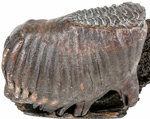 |
Mammoth Tooth Embedded In A Partial Mandible. This complete museum quality dark brown 6.75 inch wide juvenile mammoth tooth has a 5.5 inch complete root still set in a 8X5.5 inch portion of the lower jaw that reveals a very interesting honey-combed-shaped bone structure. The hollow cavities in the bone helped reduce the weight of the jaw as well as allowing blood flow throughout the bone. This museum quality fossil is 30,000-50,000 years old from Siberia where the best preserved Mammoths have been found. The flat surface of Mammoth teeth was used to grind coarse vegetation. The alternating rows of raised dark brown hard enamel and brown recessed softer dentine are clearly visible. A single complete Mammoth tooth is highly desired, but a tooth in a rtial mandible is much rarer and more valuable to understanding the Mammoths dental structure.
Estimated Value $1,000 - 1,500.
View details and enlarged photo
| Realized
$615 |
Lot 920 |
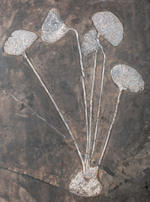 |
Five Large Complete Crinoids. Crinoids which are known as "sea lilies" are actually an echinoderm with five fold symmetry related to star fish. Finding even one complete crinoid with its stem is rare because the stem is composed of many segments and breaks apart quickly when the crinoid dies. This museum quality 15.5X12.5 inch gray stone slab contains five large complete Traomatocrinus crinoids from the Guizhou Province of China which are 240 million years old. The light gray crinoids contrast nicely against the dark gray matrix making for a dramatic fossil. The largest three crinoids are 10.5-11 inches long consisting of a 2-2.5 inch Calyx (cup or flower part) and a 8-9 inch long stem. The detail is excellent with even some of the fine feather-like pinnules visible. These sieve-like pinnules were used to capture small prey items which were transported to the mouth at the center of the Calyx. All five of the crinoids are attached to the same 2X2 inch object that was either floating in the water or perhaps anchored to the sea floor. This is a remarkably esthetic fossil which could be hung on a wall if desired.
Estimated Value $1,000 - 1,300.
View details and enlarged photo
| Realized
$1,076 |
Lot 921 |
 |
Lunar Meteorite Dhofar 911. This complete end cut of Lunar meteorite Dhofar 911 is 22mmX10X5mm and weighs .928 gram. End cuts of meteorites are particulary valued because one end is natural showing the texture and fusion crust (if present) while the other end has been polished to show the interior of the meteorite. Lunar meteorites are the most desirable and expensive of all the types of metrorites recovered from planetary bodies and are even rarer than meteorites from Mars. For some reason, all of the recovered lunar meteorites except one are small and Dhofar 911 is no different with all 9 meteorites found weighing only a total of 194 grams. These valuable small meteorites were found in the Dhofar region of the Oman desert in 2003. It has been classified as a Lunar feldspathic impact melt breccia from the Lunar highlands which means that it is a mixture of several different types of moon rocks rich in Feldspar. The Lunar highlands are the features on the moon that appear to be bright when viewed from the Earth but are actually heavily cratered area. These basaltic Lunar rocks were melted and partially mixed together when a large meteorite crashed into the moon millions of years ago. This rock mixture was vaporized and ejected from the moon and eventually made its way to the earth This colorful end cut has hues of browns and light grays with darker gray shock boundaries with various shaped white inclusions. The very valuable meteorite is large enough to be held in ones hand and is housed in a clear membrane box and a 8X6 inch Riker box and an authenticity card from the Hupe Collection.
Estimated Value $1,000 - 1,300.
View details and enlarged photo
| Realized
$615 |
Lot 922 |
 |
Ten Trilobites on One Plate. Most trilobites are found as individuals and usually fragmented. A single complete trilobite is desirable. Mass mortality groupings such as this 375 million year old 7.5X5 inch plate from Ofaten, Morocco are rare. What makes this mortality grouping even rarer as all 10 of the trilobites were buried while still alive and not just molts that occur when trilobites change their outer shells as they grow. The surface of this gray plate is covered with ten complete 1-1.5 inch long black trilobites. At first glance it looks like all ten trilobites belong to the same species but actually six trilobites belong to Cyphasis and four to Otarion. Both spiny trilobites have long pygidium spines and stalked eyes but Cyphasis also has two sharp spines that extend forward from its head (cephalon). That is the reason it has the nickname of "devil's horn". The two spines look like antennae but are made of calcite and not soft tissue like the antennae. Trilobites were one of the very first animals to have eyes and originated over 500 million years ago. More than 20 hours of professional prep work were required to remove the very life-like trilobites from their stony tomb.
Estimated Value $850 - 1,300.
View details and enlarged photo
| Realized
$523 |
Lot 923 |
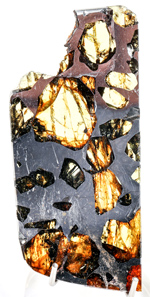 |
Esquel The Most Beautiful Pallasite. Discovered in 1951 by a farmer in Chubut, Argentina, the single 680 Kg meteorite known as Esquel has been in great demand as the most beautiful of the rare type of meteorites known as pallasites. There are three major types of meteorites, iron, stony and stony-iron. Pallasites are stony-iron meteorites that originate from the core-mantle boundary of large planetary size asteroids that were destroyed early in the formation of the solar system. This rare type of meteorite consists of iron-nickel from the core of the asteroid as well as olivine crystals known as peridot from the mantle. Peridot crystals(the gem state of olivine crystals) are the only known gem stones from space found in meteorites. Esquel is considered to be the most beautiful of all pallasites and in now rarely available as the single discovered meteorite has been completely sectioned with only the main mass end piece remaining. This 2.75X1.25 inch section of Esquel has been polished on both sides to get the maximum reflection of the iron-nickel matrix as well as displaying many beautiful translucent lightly shocked green to orange olivine crystals. It weighs 18.56 grams and is presented in a 5.5X4.5 inch Riker mount.
Estimated Value $800 - 1,000.
View details and enlarged photo
| Unsold |
Lot 924 |
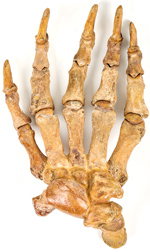 |
Cave Bear Paw. Ursus spelaeus, the famous cave bear, was the largest bear that ever lived. They would have been nine to ten feet tall when standing on their hind legs. This complete paw is between 20,000-150,000 years old and was found in caves in Romania. The paw is 9.5inches long and 5 inches wide complete with all five digits and 1.5 inch claws. The claws would have been even larger and deadlier in life being covered with keratin the same material as in our finger and toe nails. The paw is complete with a light brown color and has been mounted with wires for complete stability and display.
Estimated Value $750 - 1,000.
View details and enlarged photo
| Realized
$456 |
Lot 925 |
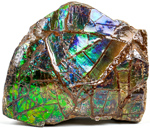 |
Iridescent Green, Purple and Blue Ammolite. Ammolite is an officially recognized gemstone that forms from the fossilization of the nacre (mother of pearl) of an ammonite in only one place on earth, the late cretaceous (70 to 80 million years ago) Bearpaw Formation of Alberta, Canada. Ammolite forms by pressure and the mineralization process that requires many millions of years and just the right condition. Ammolite was certified as a gemstone in 1981 by the World Jewelry Confederation. Ammonites are extinct mollusks that are related to modern day squid and octopus. They became extinct with the dinosaurs some 65 million years ago. This large 4.5X4X3 inch section of a sizeable ammonite has iridescent ammolite on two of its sides. The sparkling iridescent ammolite consists of green, rare purple and even some of the very rare blue color. Blue is the rarest of all of the Ammolite colors. Complete ammonites with such excellent Ammolite colors sell for at least $20,000.
Estimated Value $750 - 1,000.
View details and enlarged photo
| Realized
$720 |
Lot 926 |
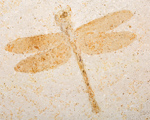 |
Dragonfly From Solnhofen. Solnhofen Germany is well known for having the first bird found in the fossil record, Archaeopterix but one of its other famous and popular fossils is the dragonfly. These 150 million year old dragonflies are beautifully preserved in the fine grain lithographic limestone matrix. This rare species Tarsophlebia exima is 3-D positive fossil perfectly positioned on a 8.25X7 inch limestone matrix with an interesting black manganese dendritic plant-like pattern at the top. The dragonfly has a 2 inch long body and a wingspan of 2 inches long and appears to be in flight. This is a complete dragonfly with a well defined head, both eyes and amazing wing detail where even the most delicate wing membranes are preserved to make this dragonfly one of the finest to be found from the famous lithographic limestone quarry of Solnhofen. Cased in a 12X8 inch Riker mount.
Estimated Value $600 - 900.
View details and enlarged photo
| Realized
$369 |
Lot 927 |
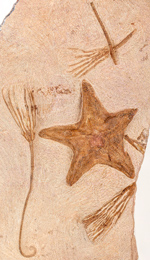 |
Starfish And Crinoids. Starfish and crinoids known as "sea lilies" are related as both belong to the genus Echinoderms. The same five-fold symmetry is present in crinoids with the number of their feeding arms being a multiple of five. This highly detailed 9.5X6 inch museum quality fossil slab is 450 million years old and was found in the Sahara desert of Morocco. The 3-D starfish is 3.5 inches long and complete. The three crinoids vary in length from 2.5-6.0 inches and consist of a crown along with some of their delicate stem still preserved intact. The crown is made up of the mouth and feeding arms which caught detritus and other small sea creatures.
Estimated Value $600 - 800.
View details and enlarged photo
| Realized
$360 |
Lot 928 |
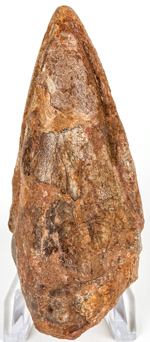 |
Spinosaurus Foot Claw. Spinosaurus was a huge theropod dinosaur that was even bigger than a T-Rex. Its enormous long narrow skull was more crocodile-like as were its unserrated peg shaped teeth. Dinosaur claws are rarely found and big claws such as this 3.5 inch complete foot claw with a perfect tip and no restoration are rarer still. Claws are much rarer than teeth because dinosaurs could replace their teeth but not their claws which were only fossilized after the dinosaur died. This 80 million year old dinosaur claw was found in the Kem Kem Valley near Taouz, Morocco. This quality dinosaur fossil is housed in a 8X6 inch Riker mount.
Estimated Value $600 - 900.
View details and enlarged photo
| Unsold |
Lot 929 |
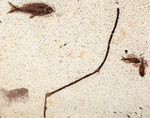 |
Green River Fish and Tree Branch. Green River Wyoming is famous for its exquisitely fossilized 50 million year old fish and plant material. These are usually found separately because most of the fish are found in deeper water than the plants which are mostly found close to the ancient lake shore. Rarely are they found together as on this large 20X19 inch limestone plate. This plate contains a large 21 inch branch of a tree with a 2 inch long twig and three Knightia fish swimming above and below the tree branch. The three Knightias (related to herring) are between 3 inches and 4 inches long complete with excellent bones and fins. The medium to dark brown fossils are nicely contrasted against the cream colored limestone matrix and make a very esthetic display.
Estimated Value $600 - 800.
View details and enlarged photo
| Unsold |
Lot 930 |
 |
Huge Spinosaurus Tooth with Partial Root. Made famous in "Jurassic Park III" as the dinosaur that killed a T-Rex, the enormous 80 million year old theropod dinosaur Spinosaurus with a huge sail on its back remains an enigmatic dinosaur as no skeleton even remotely complete has been found and the only partial skeleton was destroyed in World War II. Spinosaurus is mostly known from its teeth. This huge 5 inch tooth with a partial root is exceptional. This huge tooth was found in two pieces and the top ¾ inch of the tip was re-attached. This rare dinosaur teeth was found in the Kem Kem Valley near Taouz, Morocco (near the border with Algeria) and comes with a small plastic stand for display.
Estimated Value $500 - 700.
View details and enlarged photo
| Realized
$308 |
Lot 931 |
 |
An Unusual 380 Million Year Old Trilobite. This large dark brown 3 inch Crotalocephalus gibbus has been professionally sculpted out its limestone matrix and has exquisite detail of its bulbous head, leg- like body spines, compound eyes and even its gigantic mouth (hypostome) found underneath the head. Crotalocephalus has one of largest mouths of any trilobite and looks like some alien bug from outer space with its crinkled exoskeleton. This 3/D sculpted trilobite looks like it is jumping over the 2.5X1.75 inch limestone base that was esthetically left. This highly detailed trilobite from Alnif, Morroco took many hours of preparation time to extract it from the hard rock matrix that entombed it for over 380 million years.
Estimated Value $500 - 600.
View details and enlarged photo
| Realized
$566 |
Lot 932 |
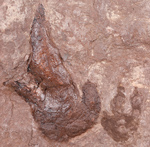 |
Pair Of Dinosaur Footprints. This pair of rare fossil dinosaur footprints are a dark brown in color on a 8.5X9 inch grayish brown shale slab. The footprints are from two different sized unknown bipedal theropod dinosaurs with the prints known as Grallator. The center toe is especially deep and well detailed with a very distinct claw and an imprint of the padding on the bottom of the toe. The second print perhaps a mother and baby dinosaur walking side by side. All of the theropod dinosaur footprints preserve just three toes as theropods walked on their 2nd, 3rd and 4th toes which correspond to the three middle human toes.
Estimated Value $400 - 600.
View details and enlarged photo
| Realized
$517 |
Lot 933 |
 |
Colorful Ammonite Cut Pair. Ammonites were early mollusks that somewhat resembled an octopus or squid living within a protective shell and are the closest relative to the chambered nautilus which still exists today. This specimen contains both halves of a 5.5 inch in diameter 110 million year old ammonite, Cleoniceras from the large island of Madagascar. This ammonite has been cut in half and polished to reveal the detail and beauty of the inner chambers. The beautiful large 5.5 inch ammonite has inner chambers that are open revealing cream colored sutures or filled with root beer colored calcite or clear quartz crystals. Two plastic stands are included for display.
Estimated Value $400 - 500.
View details and enlarged photo
| Unsold |
Lot 934 |
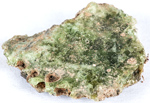 |
Trinitite From First Atomic Bomb Blast. Trinitite is a glassy light green fused silica sand that was created by the first atomic bomb blast near Alamogordo, New Mexico on July 16, 1945. The glass is mostly composed of arkosic sand primarily consisting of silica quartz grains and feldspar. The intense heat of the resulting fireball depressed a 300 yard in diameter crater transforming the desert sand beneath the crater into one of the rarest minerals on earth, Trinitite. Contained within the Trinitite are melted bits of the first atomic bomb itself as well as the supporting structure. This large specimen is 33X28X5 mm and weighs 4.6 grams which is considerably larger than most pieces available. There is a green glossy color on top of the specimen and a fused gray stone bottom. All available specimens of Trinitite were collected in the late 1940's and early 1950's. In 1953 the entire site was bulldozed and buried by the United States Atomic Energy Commission. This rare specimen is contained in a 6X5 inch Riker mount with a picture of the actual 1945 atomic explosion. Trinitite is still mildly radioactive but is considered to be safe to handle but should not be swallowed.
Estimated Value $400 - 550.
View details and enlarged photo
| Realized
$394 |
Lot 935 |
 |
Ceratosaurus Dinosaur Sculpture. Ceratosaurus, meaning horned lizard, was named because of the large thin horn on its nose. This large rare predatory theropod dinosaur lived 150 million years ago in the Morrison formation of Colorado and Utah. Its distinguishing characteristics were its large jaws filled with sharp blade-like teeth, its large thin horn on its snout and a pair of smaller horns over its eyes. This anatomically correct 3X1X1.5 inch sculptured skull was carved out of a fossilized Mammoth tusk. The sculpture was made by the artist Lee Downey in Bali, Indonesia who used a real Ceratosaurus skull as his model. Not only did he carefully sculpt the horns and teeth, but also the fenestrae (holes in the dinosaur skull that kept the massive skull from being too heavy for the dinosaur to hold up). This very realistic skull comes in a plush blue Bali Box.
Estimated Value $400 - 500.
View details and enlarged photo
| Unsold |
Lot 936 |
 |
Fossilized Mammoth Tusk. Fossil Mammoth Tusk estimated at 10 to 20 thousand years of age. Not sanded or filled in, broken at tip, nearly intact juvinile tusk still retains its appeal for fossil collectors young and old. Measures 26" x 4" x 4" and weighs close to 9 pounds. No overseas sales or to buyers in New York and New Jersey.
Estimated Value $400 - 500.
View details and enlarged photo
| Realized
$590 |
Lot 937 |
 |
Trilobite Large Drotops. Most examples of the trilobite Drotops are only 2-3 inches long, but in the warm 375 million year old seas near Erfoud, Morocco this same trilobite grew to over 6 inches in length. This large 5.5X3 inch black trilobite has been esthetically cut out of its grey stone matrix to stand up in a life-like position on its natural 2.5X2 inch stone base. Trilobites were one of the very first animals to have sharp focusing eyes.
Estimated Value $350 - 450.
View details and enlarged photo
| Unsold |
Lot 938 |
 |
Colorful Dinosaur Coprolite. This interesting fossil comes from the business end of a 150 million year old plant eating dinosaur. Coprolites are fossilized dung that can give us information about what dinosaurs ate. This very large 7X4X3 inch over 4 pound coprolite has the classic pebbly exterior surface and one end has been cut and polished to show its colorful interior which at first glance looks like a piece of petrified wood. From the Morrison Formation of Montana and represents a very large dinosaur such as a Stegosaurus or one of the huge sauropods. A somewhat larger but less colorful coprolite recently brought $6,000 at auction.
Estimated Value $350 - 450.
View details and enlarged photo
| Realized
$360 |
Lot 939 |
 |
Carcharodontosaurus Dinosaur Tooth. Large 2.5 by 1.0 inch wide complete dinosaur tooth of Carcharodontosaurus saharicus, the T-Rex of Africa.This complete light brown shed tooth has very good enamel with only minor enamel chipping which almost always occurs. All of the steak knife-like serrations are present on both edges of the tooth with only one minor break near the tip. There is just a bit of natural tooth wear on the very tip which occurred when the dinosaur was alive. This large impressive tooth was found in the Sahara desert of Morocco and Carcharodontosaurus was older than a T-Rex at 70-80 million years old. No restoration with just a little crack filling and housed in a 5X4 inch Riker mount.
Estimated Value $300 - 400.
View details and enlarged photo
| Realized
$204 |
Lot 940 |
 |
Large Mammal Coprolite. Fossilized dung. This 6.25X2.5 inch coprolite is approximately 12-26 million years old and was found in Lewis County, Washington State. You cannot tell which mammal deposited this specimen but by the large size we know that the mammal had to be large such as a cave bear, rhino or other large mammal. Comes with a redwood stand for display and would make an excellent Holiday gift for that special person in your life.
Estimated Value $250 - 350.
View details and enlarged photo
| Realized
$144 |